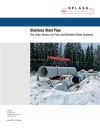Molybdenum and its applications
Stainless Steel in Water Distribution
There are millions of miles of pipelines, worldwide, used for the transmission of drinking water. These pipelines must offer corrosion resistance to the water itself, soil chemistries, and treatment chemicals in order to provide both a long service life and hygienic delivery of drinking quality water. Type 316 (2-3% Mo) stainless steel has been shown to provide the necessary corrosion resistance for most applications, at a cost competitive with other piping materials. Where additional corrosion protection might be needed, as in shoreline installations, the duplex SS (3.0-3.5% Mo) can be used to achieve the required hygiene, cost and service life.
Stainless Steel Pipe - The clear Choice for Pure and Reliable Water Systems
released in 2007
To answer the question “Why Stainless Steel?” these and other beneficial properties of the Mo containing stainless steels are summarized as follows:
- Excellent corrosion resistance - SS are significantly more resistant to oxidation by water and biocides than carbon steel and cast or ductile iron. This results in longer life time for pipelines.
- Corrosion protection – an internal and external coating is not required for SS, nor is cathodic protection. This reduces system cost and makes stainless steels more compatible with environment.
- Hygienic materials - due to their very high passive film stability, SS are basically inert in waters. Leaching of alloying elements (Cr and Ni) is within safe limits. As a result, they provide a better quality of drinking water.
- Coefficient of friction – lower friction compared to cement lined carbon steel pipes or to corroded carbon steel results in less loss of water pressure along the pipeline. This provides an opportunity to diminish the internal diameter of the pipe and save capital cost. This is also a reason for a lower adhesion of deposits as well as lower bacteria colonization. They are also tolerant to high flow rates.
- Good strength and ductility – SS, particularly the duplex materials, have higher mechanical properties when compared to carbon steel and cast iron pipes. This allows a reduction in the wall thickness of the pipe (with out any required corrosion allowance) and results in investment cost savings. The better ductility may also be important in terms of security, e.g. in the case of an earthquake.
- Erosion-corrosion – the duplex stainless steels are much more resistant to erosion-corrosion than carbon steel, particularly if sand particles are present.
- Ease of fabrication – the SS are adaptable materials: ease of forming, machining and welding, combined with their good ductility, permit easy installation and modifications of pipelines. They are also available in a wide variety of product forms.
- Ease of maintenance - with high corrosion resistance and easy welding, water leaks can be drastically reduced, probably from 25% down to less than 5% which leads to further cost savings. This argument is more and more important due to the increase in the cost of water and water treatment.
- Excellent durability - as SS are resistant to crevice corrosion, cavitation and wear in pure and polluted waters as well as in atmosphere (even polluted), they are cost effective for long term use and do not cause environmental pollution.
- Recyclable - SS are 100% recyclable and a part of their initial cost may be recoverable when they are recycled.

